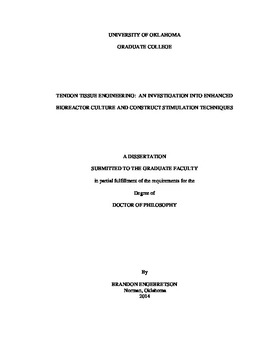| dc.description.abstract | Tendon tissue engineering is a field that arose as there became a need for alternatives for surgical grafts utilized in injured tendon treatments. This is due to either underperforming current technology of off the shelf materials or the fact that there is a limited supply of autografts, which is the gold standard for tendon grafting. Tendon tissue engineering utilizes all the aspects of the broader tissue engineering field: an appropriate scaffold, a cell source, and stimulation through mechanical and chemical means. This approach adopted herein utilizes the human umbilical vein (HUV) as a scaffold and mesenchymal stem cells (MSCs) for a cell source as a tendon construct. Previous studies have utilized a custom bioreactor to provide mechanical stimulation to this construct in the form of cyclical stretching. Two week cultures increased the mechanical properties, cellularity, and ECM quality of the umbilical vein, improving the construct as a tissue engineered tendon. The following studies built upon the foundation of the previous research to elucidate the importance of the different parameters comprising the mechanical and chemical stimulation.
The first study presented investigated altering the duration and frequency of the mechanical stimulation. This was done to improve early construct quality by varying the two previously mentioned parameters. By improving early time point culture, the future development of the tissue could be greatly improved. The durations investigated included 0.5, 1, and 2 hours/day and the frequencies investigated were 0.5, 1, and 2 cycles/minute. All dynamic stimulations increased cellular proliferation except for 2 cycles/min and 2 hours/day. A 1 cycle/minute frequency resulted in the greatest cellular proliferation (170% increase) while the 0.5 hour/day duration was best (203% increase). Extracellular matrix quality had a direct relation to significant increases in cellularity, those groups showing the highest matrix deposition and alignment of the matrix. Gene expression indicated cellular activity consistent with remodeling the scaffold to be more tendon-like in terms of biglycan and elastin. In addition, scleraxis, tenascin-C, and tenomodulin were upregulated in certain stimulations after at most 7 days, with non-tendon phenotypes depressed. The stimulation parameters investigated in this study indicated that slower frequencies and shorter durations such as 0.5 cycles/min and 0.5 hours/day were best for construct quality when short term (up to 1 week) culture are employed.
The second study involved chemical stimulation of the construct. This study aimed to find if an extract of tenocytes can positively affect the development of the HUV/MSC construct that also underwent cyclical mechanical stimulation. This extract possesses soluble factors and genetic material from tendons that could potentially influence MSC behavior. By supplementing with tenocytic extract, a synergistic effect could be obtained with the aforementioned improved method of mechanical stimulation of the construct. After 14 days of dynamic culture, extract supplemented constructs possessed higher cellularity (37% and 150%) and tensile strengths (33% and 45%) when compared to non-supplemented MSC or tenocyte groups respectively. In addition, histological images indicated the extract supplemented constructs cultured dynamically possessed a dense connective tissue structure similar to native tendon. Gene expression profiles indicated that the dynamic construct initially expressed higher amounts of collagen type I rather than specific tenocytic markers after 7 days. However, after 14 days of dynamic culture, tenocytic marker and tendon development genes such as elastin, scleraxis, and tenomodulin were upregulated, indicating a tendency towards a tendon phenotype greater than the non-supplemented group, which only received mechanical stimulation. This indicated that chemical stimulation, in addition to the improved upon mechanical stimulation in the previous study, allowed for further improvements in the culture compared to either of the two individual stimuli.
Finally the third study investigated the effects of long term culture (up to 4 weeks) on the construct. This was important, due to the fact that the previous two studies were limited in culture duration due to the bioreactor and construct design, which in turn limited the improvements in the overall construct. In this study, the HUV/MSC construct was modified to be suitable for long term culture within the bioreactor by opening the construct into a flat sheet to overcome nutrient transport limitations observed in previous studies. By providing a longer culture time, the construct properties could be improved by allowing for more cell and tissue growth. Opening the construct initially into a flat sheet increased cell numbers by 15.3 fold along with an increased tensile strength of 3.7 ± 0.7 MPa. However, analysis by RT-PCR showed upregulation of the osteoblastic markers osterix in the MSCs after 21 days and osteocalcin after 28 days, along with delayed tenocytic development. In contrast, by culturing the construct in its original cylindrical form for 2 weeks, MSCs are protected from the shear forces in their early developmental stages that may have increased the osteoblastic tendencies of the MSCs. After 2 weeks, the HUV is cut open into a flat sheet to allow for direct exposure to circulating media. By doing this, cell numbers did increase throughout the culture time but were 71% less than the initially open construct. However, the ultimate tensile strength after 28 days was 5.6 ± 0.7 MPa, 50% higher than the initially open construct. Gene expression analysis showed earlier tenocytic differentiation with the initially closed construct while osterix and osteocalcin expression was continually downregulated throughout the 28 days.
Overall, with the improvements provided by this study, the construct increased its ultimate tensile strength by 37% compared to previous studies and the MSCs utilized in this study have shown to differentiate towards a tenocytic linage and remodel the scaffold with more tendon-like characteristics and an overall higher quality ECM. These properties approached some of the properties of native tendons in the body, indicating that the HUV/MSC construct in its current form, with further improvements can be a viable alternative to current technologies for treating tendon injuries. | en_US |
